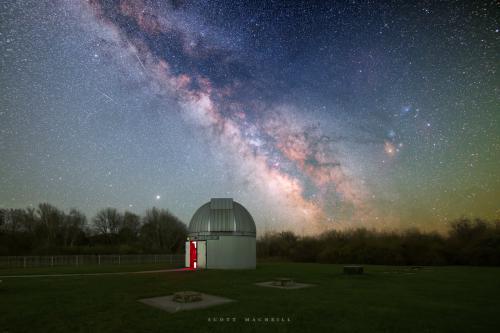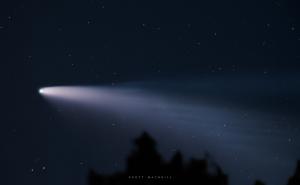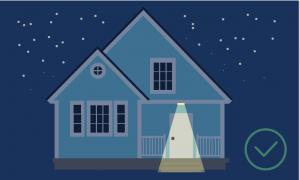Celebration of Space - April 22, 2022

Lyrid meteors shoot over Frosty Drew Observatory with the Milky Way blazing brightly in April 2020. Image credit: Frosty Drew Astronomy Team member, Scott MacNeill
Early this morning, Friday, April 22, 2022, the annual Lyrid Meteor Shower peaked. We did not put out a lot of info about the Lyrids this year because the shower is not usually very active and we had the bright waning gibbous Moon in the sky this morning, which obscured pretty much all Lyrid meteors. Though the Lyrid Meteor Shower is worth noting because it is the first moderate meteor shower to occur since the Quadrantid Meteor Shower, which occurred on January 3rd. The Lyrids also kick off meteor viewing season which will run through the end of the year. The next meteor shower to keep your eyes on will peak on the morning of May 5, 2022. The shower is called the Eta Aquariids, and the timings in 2022 are fantastic as the New Moon will occur on April 30th, after which the Moon will move into the evening sky, leaving the morning sky super dark. This will also give viewers an opportunity to see the Milky Way over Frosty Drew Observatory when it is at its best! The morning hours in April and May are the best times to catch sight of the Milky Way over our location. Plan to be out at a dark location for 2:00 am on Thursday, May 5th to catch a view of the Milky Way silhouetted by the occasional Eta Aquariid meteor.
In July 2021 a new Oort Cloud comet was discovered. The comet has been quickly moving into the inner Solar System and performed a rather close perihelion yesterday, April 21, 2022. Perihelion is the comet’s closest point to the Sun, the point at which the comet swings around the Sun, and begins its journey back out to the Oort Cloud. Perihelion occurred at a distance of 26,706,734 miles from the Sun. Which is inside the distance that Mercury orbits the Sun. Since the comet is new to the inner solar system, it is very dynamic, and passing that close to the Sun could cause the comet to significantly out-gas, break apart, or fragment. All of which could seriously brighten the comet. As the comet continues to orbit away from the Sun, it will continue to approach Earth. The closest point the comet will be to Earth will be Monday, May 9, 2022, and will pass us at a distance of 55,847,681 miles. Sorry doomsayers, no impact concern there. The comet is currently quite close to the Sun for viewing, but it is likely visible in binoculars now. If the comet undergoes fragmentation, we could end up with a bright comet for late April and early May that is visible in the evening sky. We’ll keep an eye on the comet and if viewings appear to be good, we will post about it and possibly host some special viewing events!
Starting today, April 22, 2022 and continuing until Saturday, April 30, 2022 is the annual International Dark Sky Week. Though I would like to write good things about this week of awareness, there really aren’t any good things to say. In truth humanity is failing, miserably, in this area, and it is frustrating to me that we are because we absolutely should not be. Losing the night sky is right up there on the list of disaster legacies that we are leaving our children. That view of the sky, the Milky Way, and thousands of stars is what has inspired humanity to do great things since the dawn of our species. The reasons for the loss of the night sky are completely ridiculous as well, and can easily be accomplished without damage to the sky. Though in all of this I have noticed a sad pattern. Many people that are so active in trying to address and work with climate change are completely ignorant to their own terrible and unnecessary use of lighting, which is part of the climate change problem! Humanity does not own the Earth, we don’t even live here, we are PART of here, just like everything else. For us to take away the sky from everything else that is part of here is not only incredibly pretentious, but also incredibly irresponsible. Especially from a species that thinks it’s the smartest one here. If you have lights outside your house or business that are on all night and/or utilize lights that are not properly shielded, then you are part of the problem.
Properly shielded lights can be defined as any light that only casts light downward and does not cast light outward any higher than 10° below the horizon. A good way to tell if your light is a problem is to walk around a 100 foot radius with the light as the center point, and stay in direct view of the light fixture. Check if you can see the bright light source from any location along that radius or further out. If you can, that light, and you, are contributing to climate change. If you cannot see the light source but only see the illuminated area that the light is casting on, then that light is properly shielded. Now the height of the light will matter when performing this check. If you are as tall as the light, then you should never see the bright light source, no matter how close you are. If the light is 5 feet taller than you then you should only have to step back 20 feet to lose sight of the light source.
Lights do not need to be on all night and are actually not accomplishing what you think they are. An anecdote on this is my home. We keep our exterior lighting off, practically all the time. The only time we use it is if we are expecting visitors, we use the equivalent of 25-40 watts, and we turn them off the moment our visitors leave. Our home has never had a break in, though our neighborhood has had many. Most people do not even know our house is there. But all the other homes with super bright lights are obvious. From a position of security and illumination, a motion sensitive light is by far the way to go! It will offer an element of surprise to an intruder as well as alert you to their presence. It can also alert you to cool natural aspects of your yard, like nocturnal wildlife passing through, and it will illuminate your outdoor movements when you are actually outdoors and need it. Outside of these events the light is off, not wasting energy, and not contributing to sky loss.
Climate change linkage and lighting comes down to several things. For one it uses energy, and it doesn’t matter where you get your energy from (or think you get your energy from), coal burning is still a huge source of electricity and the more energy we use the dirtier production gets! LED does NOT solve this, and if you think that it does, then you bought the line of the salesperson. Light cast into the sky is pollution, and it does affect the habitat that we are part of. In fact, it not only affects the habitat, but it affects humans! We need darkness to survive, it is how we evolved. Part of the climate change problem is the extinction of species due to human activities, and light pollution is directly related to this problem!
Unlike the increase in greenhouse gasses from human activities, the light pollution issue is super easy to solve. Really, just turn off your lights. But if you need them, upgrading to the right lighting technology will also solve the problem. Here are some examples. Additionally, installing motion sensors on existing lighting is a simple, inexpensive solution to the problem. Let’s take this week to evaluate what we are doing to the environment, and don’t just assume that because it’s you that you are doing everything right. Each day brings us a chance to better ourselves, and this is one area that is so easy to accomplish a higher position of responsibility! Here are additional resources to get in the know about the problem.
Today, April 22, 2022 is also Earth Day. For some ideas on how you can get involved in protecting the habitability of Earth for humans, re-read the above five paragraphs. Thank you for caring!
- Author:
- Scott MacNeill
- Entry Date:
- Apr 22, 2022
- Published Under:
- Scott MacNeill's Columns





